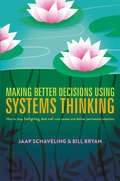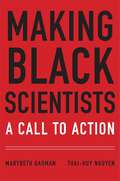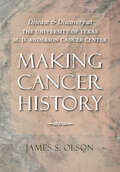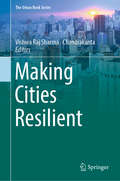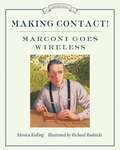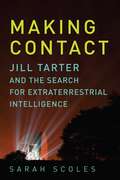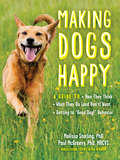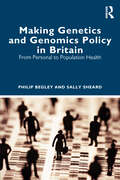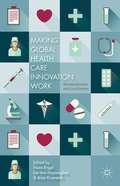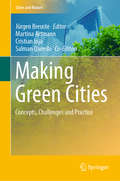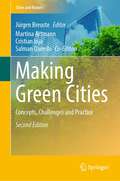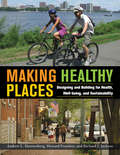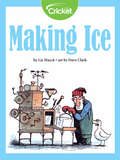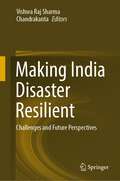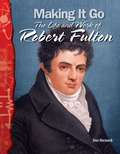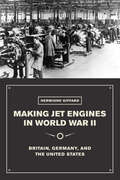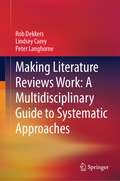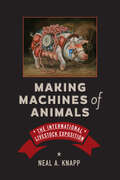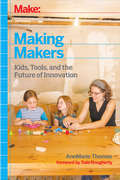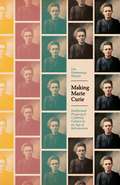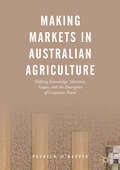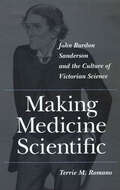- Table View
- List View
Making Better Decisions Using Systems Thinking
by Bill Bryan Jaap SchavelingThis book provides a framework to help managers go beyond simply fighting fires every day, offering the tools to address the underlying causes of recurring problems and deliver long-term solutions. The most obvious part of any problem is the pain it causes. The desire to end the pain and find a solution - any solution - that will make it go away now is usually so great that it blinds managers to the underlying systemic cause of the problem. The result is that we 'solve' the problem today and then it comes back again tomorrow or next week, again and again. We are only addressing the symptoms but never understanding the cause - like picking the flower heads off weeds but not digging them out at the roots. Schaveling and Bryan offer the insights and tools managers and leaders need to achieve a longer term and more effective approach by stepping back and analysing the system as a whole. And at the heart of any system are human beings - notoriously short-term and pain-averse creatures who will behave in whatever way minimises pain today even at the expense of pain tomorrow. They show how to detect the behavior patterns that have become engrained in the organisation and which underlie complex situations so that root causes of problems can be identified. Once the system responsible for the problem is understood smarter decisions can be made to devise interventions that solve the core problem instead of wasting energy fighting the symptoms.
Making Black Scientists: A Call to Action
by Marybeth Gasman Thai-Huy NguyenHistorically black colleges and universities are adept at training scientists. Marybeth Gasman and Thai-Huy Nguyen follow ten HBCU programs that have grown their student cohorts and improved performance. These science departments furnish a bold new model for other colleges that want to better serve African American students.
Making Cancer History: Disease and Discovery at the University of Texas M. D. Anderson Cancer Center
by James S. OlsonThe history of the M. D. Anderson Cancer Center vividly reveals how cancer treatment in America—and our attitudes toward the disease—has changed since the middle of the twentieth century.One of the preeminent cancer centers in the world, M. D. Anderson is also one of the first medical institutions devoted exclusively to caring for people with cancer and researching treatments and cures for the disease. Historian James S. Olson’s narrative relates the story of the center’s founding and of the surgeons, radiologists, radiotherapists, nurses, medical oncologists, scientists, administrators, and patients who built M. D. Anderson into the world-class institution it is today. Through interviews with M. D. Anderson’s leaders and patients, Olson brings to life the struggle to understand and treat cancer in America. A cancer survivor who has himself been treated at the center, Olson imbues this history with humor, passion, and humanity.
Making Cities Resilient (The Urban Book Series)
by Chandrakanta Vishwa Raj SharmaAs the world has transformed, so have cities. Today, cities are home to 54 percent of the world’s population, and by the middle of this century that figure will likely rise to 66 percent. According to the United Nations (UN) Habitat I (1972), Habitat II (1996) and Habitat III (2016) summits, cities are facing many serious challenges, including growing inequality, security concerns and the worsening impacts of climate change. Uncontrolled urbanization has led to many problems (haphazard growth of areas, emergence of slums, inadequate water and power supply, poor sanitation, shortage of transport and other civic amenities, shrinking green spaces, pollution, crime, and urban disaster risks such as fire, flood, road and industrial accidents, etc.). Worldwide, communities at the international, national and local level are continuously working to improve human habitats. In order to make our planet more sustainable, the UN has moved from the Millennium Development Goals (MDG) to the Sustainable Development Goals (SDG). Among the latter, the aim of SDG 11 is to “…make cities and human settlements inclusive, safe, resilient and sustainable.” In light of these challenges, various terms have emerged to help understand urban issues. Visualizing the problem, the United Nations program “Making Cities Resilient” is focused on mitigating the disaster risk in urban areas. This book analyzes terms such as: sustainable, resilient, livable, inclusive, smart and world class city, which have emerged in the process of combating urban challenges in today’s world. The book addresses emerging concepts for cities, challenges and potentials, urban environments, health and planning/policies. Covering 14 large cities in India, as well as case studies from Japan, Singapore, Thailand, Malaysia, Poland and Sweden, it provides a regional dimension to and micro-level perspective on urban issues.
Making Contact!: Marconi Goes Wireless (Great Idea Series #5)
by Monica KullingThe fifth book in Tundra's Great Idea Series, Making Contact! tells the story of Guglielmo Marconi, who became the father of wireless communication. As a boy, Marconi loved science and invention. Born in 1874 in Bologna, Italy, to a wealthy family, Marconi grew up surrounded by books in his father's library. He was fascinated with radio waves and learned Morse code, the language of the telegraph. A retired telegraph operator taught him how to tap messages on the telegraph machine. At the age of twenty, Marconi realized that no one had invented a wireless telegraph. Determined to find a way to use radio waves to send wireless messages, Marconi found his calling. And, thanks to his persistence, on December 12, 1901, for the first time ever, a wireless signal traveled between two continents. The rest is history. Monica Kulling's playful, informative text, combined with the compelling illustrations of artist Richard Rudnicki, bring an amazing inventor and his times to life.
Making Contact: Jill Tarter And The Search For Extraterrestrial Intelligence
by Sarah ScolesFor anyone who has ever looked up at the night sky and wondered, "Are we alone?" A brilliant examination of the science behind the search for extraterrestrial intelligence and its pioneer, Jill Tarter, the inspiration for the main character in Carl Sagan's Contact. Jill Tarter is a pioneer, an innovator, an adventurer, and a controversial force. At a time when women weren’t encouraged to do much outside the home, Tarter ventured as far out as she could—into the three-Kelvin cold of deep space. And she hasn’t stopped investigating a subject that takes and takes without giving much back. Today, her computer's screensaver is just the text “SO…ARE WE ALONE?” This question keeps her up at night. In some ways, this is the question that keep us all up at night. We have all spent dark hours wondering about our place in it all, pondering our "aloneness," both terrestrial and cosmic. Tarter’s life and her work are not just a quest to understand life in the universe: they are a quest to understand our lives within the universe. No one has told that story, her story, until now. It all began with gazing into the night sky. All those stars were just distant suns—were any of them someone else's sun? Diving into the science, philosophy, and politics of SETI—searching for extraterrestrial intelligence—Sarah Scoles reveals the fascinating figure at the center of the final frontier of scientific investigation. This is the perfect book for anyone who has ever looked up at the night sky and wondered if we are alone in the universe.
Making Dogs Happy: A Guide to How They Think, What They Do (and Don't) Want, and Getting to "Good Dog!" Behavior
by Paul McGreevy Melissa StarlingLearn to decode your dog&’s emotions and behaviors—and be the best dog parent you can be—with this guide by two leading experts in canine behavior. &“Why does my dog do that?&” is a question every dog owner has asked, whether their best friend is growling at an unseen foe, or rolling in something that smells terrible. In Making Dogs Happy, dog trainer Melissa Starling and veterinarian Paul McGreevy supply all the answers: How dogs use body language to communicate (with both people and other dogs)What motivates dogs (and what doesn&’t)Rules for canine contentment (for example, most dogs don&’t enjoy hugging)Subtle signs of discomfort, stress, and fear (like lip licking)And even how to choose the furry companion that&’s right for you. In Making Dogs Happy, you&’ll learn to see the world as your dog does—full of goals to pursue, resources to guard, and stressors to avoid. Using that knowledge, you&’ll be able to communicate with and train your dogs—and keep them happy.
Making Faces
by Adam S. WilkinsAdam Wilkins draws on studies of nonhuman species, the fossil record, genetics, and molecular and developmental biology to reconstruct the evolution of the human face and its inextricable link to our species’ evolving social complexity. The neural and muscular mechanisms that allowed facial expressions also led to speech, which is unique to humans.
Making Genetics and Genomics Policy in Britain: From Personal to Population Health
by Sally Sheard Philip BegleyThis important book traces the history of genetics and genomics policy in Britain. Detailing the scientific, political, and economic factors that have informed policy and the development of new health services, the book highlights the particular importance of the field of Public Health Genomics. Although focused primarily on events in Britain, the book reveals a number of globally applicable lessons. The authors explain how and why Public Health Genomics developed and the ways in which genetics and genomics have come to have a central place in many important health debates. Consideration of their ethical, social, and legal implications and ensuring that new services that are equitable, appropriate, and well-targeted will be central to effective health planning and policymaking in future. The book features: Interviews with leading individuals who were intimately involved in the development of genetics and genomics policy and Public Health Genomics. Insights from experts who participated in a pair of 'witness seminars'. Historical analysis exploiting a wide range of primary sources. Written in a clear and accessible style, this book will be of interest to those involved in the research and practice of genetics, genomics, bioethics, and population health, but also to NHS staff, policymakers, politicians, and the public. It will also be valuable supplementary reading for students of the History of Medicine and Health, Public Health, and Biomedical Sciences.
Making Global Health Care Innovation Work: Standardization and Localization
by Edited by Nora Engel Ine Van Hoyweghen Anja KrumeichGlobal Health involves, among many things the intensified travelling of people, resources, technologies, knowledge, standards, and ideas. This book describes what happens when innovations are transferred to new settings: What work is needed to make them work, but also how they change the setting into which they are introduced.
Making Green Cities: Concepts, Challenges and Practice (Cities and Nature)
by Jürgen Breuste Martina Artmann Cristian Ioja Salman QureshiThis book shows what role nature can play in a city and how this can make it a better place for people to live. People, planners, designers and politicians are working towards the development of green cities. Some cities are already promoted as green cities, while others are on their way to become one. But their goals are often unclear and can include different facets. Presenting contributions from world leading researchers in the field of urban ecology, the editors provide an interdisciplinary overview of best practices and challenges in creating green cities. They show examples of how to build up these cities from bits and pieces to districts and urban extensions. Each example concludes with a summary of the collected knowledge, the learning points and how this can be used in other places. The best practices are collected from around the world – Europe, Australia, America and Asia. The new dynamic urban development of Asia is illustrated by case studies from China and the Indian subcontinent. The reader will learn which role nature can play in green cities and what the basic requirements are in terms of culture, pre-existing nature conditions, existing urban surroundings, history, design and planning.
Making Green Cities: Concepts, Challenges and Practice (Cities and Nature)
by Jürgen Breuste Martina Artmann Cristian Ioja Salman QureshiThis book shows what role nature can play in a city and how this can make it a better place for people to live. People, planners, designers and politicians are working towards the development of green cities. Some cities are already promoted as green cities, while others are on their way to become one. But their goals are often unclear and can include different facets. Presenting contributions from world leading researchers in the field of urban ecology, the editors provide an interdisciplinary overview of best practices and challenges in creating green cities. They show examples of how to build up these cities from bits and pieces to districts and urban extensions. Each example concludes with a summary of the collected knowledge, the learning points and how this can be used in other places. The best practices are collected from around the world – Europe, America and Asia. Contributions cover a wide range of biophysical and cultural backgrounds within these three continents, including the Central, Southern and Eastern European region, as well as Latin and North America. The new dynamic urban development of Asia is illustrated by case studies from China and the Indian subcontinent. The reader will learn which role nature can play in green cities and what the basic requirements are in terms of culture, pre-existing nature conditions, existing urban surroundings, history, design and planning.
Making Healthcare Green: The Role of Cloud, Green IT, and Data Science to Reduce Healthcare Costs and Combat Climate Change
by Nina S. Godbole John P. LambThis book offers examples of how data science, big data, analytics, and cloud technology can be used in healthcare to significantly improve a hospital’s IT Energy Efficiency along with information on the best ways to improve energy efficiency for healthcare in a cost effective manner. The book builds on the work done in other sectors (mainly data centers) in effectively measuring and improving IT energy efficiency and includes case studies illustrating power and cooling requirements within Green Healthcare.Making Healthcare Green will appeal to professionals and researchers working in the areas of analytics and energy efficiency within the healthcare fields.
Making Healthy Places
by Richard J. Jackson Andrew L. Dannenberg Howard FrumkinThis book provides a far-reaching follow-up to the pathbreaking Urban Sprawl and Public Health, published by Island Press in 2004. That book sparked a range of inquiries into the connections between constructed environments, particularly cities and suburbs, and human health. Since then, numerous studies have extended and refined the book's research and reporting. Making Healthy Places offers a fresh and comprehensive look at this vital subject today, from the scale of buildings up to the scale of metropolitan areas. There is no other book with the depth, breadth, vision and accessibility that this book offers. Like a well-trained doctor, it presents a diagnosis of-and offers treatment for-problems related to the built environment. Drawing on the latest scientific evidence, with contributions from experts in a range of fields, it imparts a wealth of practical information, emphasizing demonstrated and promising solutions to common problems. Health professionals, planners, architects, developers, elected officials, students, and concerned members of the public will find this book invaluable.
Making India Disaster Resilient: Challenges and Future Perspectives
by Chandrakanta Vishwa Raj SharmaVarious natural and man-made hazards are nowadays increasingly considered as disasters, particularly by individual and communities are lacking in awareness and where a system as a whole has no adequate management mechanism. Consequently, the world is facing serious negative outcome in form of loss of life, injury, disability, loss of property, infrastructure, and economic disruption followed by psycho-social disorders. Other than this, disasters adversely affect wildlife and environment in long terms. Developing countries are worst sufferers as these regions are poorly prepared for potential hazards at one hand and are exposed to disasters due to the complexity of (socio-cultural, economic and physical) vulnerability. Government, World communities, NGOs are recognizing the problems and are trying to build resilient communities to reduce disaster impact at various levels.Year 1990-99 was observed as the decade for natural disaster reduction by United Nations (UN) and United Nations International Strategy for Disaster Reduction (UNISDR) was established to support and coordinate this movement. Year 2015 has been very important in the history as three global agreements have been signed by global communities (Sustainable development goals, Paris agreement and Sendai framework for DRR). Where, SDGs are extension of MDGs to make the planet more sustainable. It proposed 17 goals and 15 years’ time frame adopted in the year 2015. SDGs target various social, cultural, economic, challenges followed by wildlife, environmental protection through knowledge share and technological innovation among all member countries. In December 2015, UNFCCC reached a landmark agreement to combat climate change and to accelerate and intensify the actions and investments needed for a sustainable low carbon future known as Paris agreement. Sendai Framework 2015 is voluntary, non-binding agreement which recognizes that the state has the primary role to reduce disasterrisk but that responsibility should be shared with other stakeholders including local government, the private sector and other stakeholders. This framework focuses on the pre-disaster management rather than post disaster relief and recovery. This book is an insight into the various issues related to the emerging disasters (both natural and man-made), vulnerable communities, and government initiatives taken with a geographical focus on India. This volume contains selected chapters written by faculty and research scholars. This book is an empirical work on disasters vulnerabilities and management which will benefit researchers, academicians, professional, practitioners and policy makers.
Making It Go: The Life And Work Of Robert Fulton
by Don HerweckRobert Fulton is best known for inventing the first successful steamboat, but that is just one of his many accomplishments. Fulton was an inventor, artist, statesman, mechanic, and engineer who used his artistic skills to sketch his inventions, which he also built. He even designed what would become the submarine.
Making Jet Engines in World War II: Britain, Germany, and the United States
by Hermione GiffardOur stories of industrial innovation tend to focus on individual initiative and breakthroughs. With Making Jet Engines in World War II, Hermione Giffard uses the case of the development of jet engines to offer a different way of understanding technological innovation, revealing the complicated mix of factors that go into any decision to pursue an innovative, and therefore risky technology. Giffard compares the approaches of Britain, Germany, and the United States. Each approached jet engines in different ways because of its own war aims and industrial expertise. Germany, which produced more jet engines than the others, did so largely as replacements for more expensive piston engines. Britain, on the other hand, produced relatively few engines--but, by shifting emphasis to design rather than production, found itself at war's end holding an unrivaled range of designs. The US emphasis on development, meanwhile, built an institutional basis for postwar production. Taken together, Giffard's work makes a powerful case for a more nuanced understanding of technological innovation, one that takes into account the influence of the many organizational factors that play a part in the journey from idea to finished product.
Making Literature Reviews Work: A Multidisciplinary Guide to Systematic Approaches
by Peter Langhorne Rob Dekkers Lindsey CareyThis textbook guides the reader on how to undertake high-quality literature reviews, from traditional narrative to protocol-driven reviews. The guidance covers a broad range of purposes, disciplines and research paradigms. Whether the literature review is part of a research project, doctoral study, dissertation or a stand-alone study, the book offers approaches, methods, tools, tips and guidelines to produce more effective literature reviews in an efficient manner. The numerous examples are drawn from an array of subject areas, such as economics, healthcare, education, medicine, psychology, software engineering amongst others. This makes it worthwhile for a wide range of studies and for reviews into evidence-based interventions, policies, practices and treatments. There is attention given to presenting, reporting and publishing literature reviews. With the additional clarity brought about by explanatory tables and graphs, this textbook is a ‘must-have’ for all students, researchers, academics and practitioners at any stage of their project or career when engaging with literature. In addition, citizens, policymakers and practitioners will benefit from the guidance with better insight into how literature reviews could and should have been conducted.
Making Machines of Animals: The International Livestock Exposition (Animals, History, Culture)
by Neal A. KnappHow the Chicago International Livestock Exposition leveraged the eugenics movement to transform animals into machines and industrialize American agriculture.In 1900, the Chicago International Livestock Exposition became the epicenter of agricultural reform that focused on reinventing animals' bodies to fit a modern, industrial design. Chicago meatpackers partnered with land-grant university professors to create the International—a spectacle on the scale of a world's fair—with the intention of setting the standard for animal quality and, in doing so, transformed American agriculture.In Making Machines of Animals, Neal A. Knapp explains the motivations of both the meatpackers and the professors, describing how they deployed the International to redefine animality itself. Both professors and packers hoped to replace so-called scrub livestock with "improved" animals and created a new taxonomy of animal quality based on the burgeoning eugenics movement. The International created novel definitions of animal superiority and codified new norms, resulting in a dramatic shift in animal weight, body size, and market age. These changes transformed the animals from multipurpose to single-purpose products. These standardized animals and their dependence on off-the-farm inputs and exchanges limited farmer choices regarding husbandry and marketing, ultimately undermining any goals for balanced farming or the maintenance and regeneration of soil fertility.Drawing on land-grant university research and publications, meatpacker records and propaganda, and newspaper and agricultural journal articles, Knapp critiques the supposed market-oriented, efficiency-driven industrial reforms proffered by the International, which were underpinned by irrational, racist ideologies. The livestock reform movement not only resulted in cruel and violent outcomes for animals but also led to twentieth-century crops and animal husbandry that were rife with inefficiencies and agricultural vulnerabilities.
Making Makers: Kids, Tools, and the Future of Innovation
by AnnMarie ThomasThis is a book for parents and other educators—both formal and informal, who are curious about the intersections of learning and making. Through stories, research, and data, it builds the case for why it is crucial to encourage today’s youth to be makers—to see the world as something they are actively helping to create. For those who are new to the Maker Movement, some history and introduction is given as well as practical advice for getting kids started in making. For those who are already familiar with the Maker Movement, this book provides biographical information about many of the “big names” and unsung heroes of the Maker Movement while also highlighting many of the attributes that make this a movement that so many people are passionate about.
Making Marie Curie: Intellectual Property and Celebrity Culture in an Age of Information
by Eva Hemmungs WirténIn many ways, Marie Curie represents modern science. Her considerable lifetime achievements--the first woman to be awarded a Nobel Prize, the only woman to be awarded the Prize in two fields, and the only person to be awarded Nobel Prizes in multiple sciences--are studied by schoolchildren across the world. When, in 2009, the New Scientist carried out a poll for the "Most Inspirational Female Scientist of All Time," the result was a foregone conclusion: Marie Curie trounced her closest runner-up, Rosalind Franklin, winning double the number of Franklin's votes. She is a role model to women embarking on a career in science, the pride of two nations--Poland and France--and, not least of all, a European Union brand for excellence in science. Making Marie Curie explores what went into the creation of this icon of science. It is not a traditional biography, or one that attempts to uncover the "real" Marie Curie. Rather, Eva Hemmungs Wirtén, by tracing a career that spans two centuries and a world war, provides an innovative and historically grounded account of how modern science emerges in tandem with celebrity culture under the influence of intellectual property in a dawning age of information. She explores the emergence of the Curie persona, the information culture of the period that shaped its development, and the strategies Curie used to manage and exploit her intellectual property. How did one create and maintain for oneself the persona of scientist at the beginning of the twentieth century? What special conditions bore upon scientific women, and on married women in particular? How was French identity claimed, established, and subverted? How, and with what consequences, was a scientific reputation secured? In its exploration of these questions and many more, Making Marie Curie provides a composite picture not only of the making of Marie Curie, but the making of modern science itself.
Making Markets in Australian Agriculture: Shifting Knowledge, Identities, Values, and the Emergence of Corporate Power
by Patrick O'KeeffeThis book provides a genealogical study of Australian agricultural restructuring, focusing on the case study of wheat export market deregulation. This policy shift was implemented in 2008, ending 60 years of statutory wheat marketing. At the time, policy makers claimed that market liberalisation would empower individual growers, providing them with choice and freedom through uninhibited participation in markets. However, regional wheat markets have become concentrated, and are increasingly controlled by a small number of transnational agribusiness firms, which have been increasingly active in setting the policy agenda in Australian agriculture. The book delves into the discursive construction of policy truths such as efficiency, competition, and the consumer, to understand how this shift was made possible, whose interests have been served, and what the implications of this shift have been. This book focuses on the machinations which contributed to this shift by examining the construction of knowledge, values and identities, which have helped to make the transition from the public to the private appear as a logical, common sense solution to the challenges facing Australian agriculture. The author shows how governmental technologies such as audit, cost-benefit analysis, performance objectives and the consumer were used to make this reality operable. In doing so, he argues that this shift should be viewed as part of the broader restructuring of Australian society, which has facilitated the transference of economic and policy making power from the public to the private.
Making Medicine Scientific: John Burdon Sanderson and the Culture of Victorian Science
by Terrie M. RomanoIn Victorian Britain scientific medicine encompassed an array of activities, from laboratory research and the use of medical technologies through the implementation of sanitary measures that drained canals and prevented the adulteration of milk and bread. Although most practitioners supported scientific medicine, controversies arose over where decisions should be made, in the laboratory or in the clinic, and by whom—medical practitioners or research scientists. In this study, Terrie Romano uses the life and eclectic career of Sir John Burdon Sanderson (1829-1905) to explore the Victorian campaign to make medicine scientific.Sanderson, in many ways a prototypical Victorian, began his professional work as a medical practitioner and Medical Officer of Health in London, then became a pathologist and physiologist and eventually the Regius Professor of Medicine at Oxford. His career illustrates the widespread support during this era for a medicine based on science. In Making Medicine Scientific, Romano argues this support was fueled by the optimism characteristic of the Victorian age, when the application of scientific methods to a range of social problems was expected to achieve progress. Dirt and disease as well as the material culture of experimentation —from frogs to photographs—represent the tangible context in which Sanderson lived and worked. Romano's detailed portrayal reveals a fascinating figure who embodied the untidy nature of the Victorian age's shift from an intellectual system rooted in religion to one based on science.
Making Medicine Scientific: John Burdon Sanderson and the Culture of Victorian Science
by Terrie M. RomanoA biography of the English physician and scientist and a history of the advancement of science in the Victorian era.In Victorian Britain, scientific medicine encompassed an array of activities, from laboratory research and the use of medical technologies through the implementation of sanitary measures that drained canals and prevented the adulteration of milk and bread. Although most practitioners supported scientific medicine, controversies arose over where decisions should be made, in the laboratory or in the clinic, and by whom—medical practitioners or research scientists. In this study, Terrie Romano uses the life and eclectic career of Sir John Burdon Sanderson (1829-1905) to explore the Victorian campaign to make medicine scientific.Sanderson, a prototypical Victorian, began his professional work as a medical practitioner and Medical Officer of Health in London, then became a pathologist and physiologist and eventually the Regius Professor of Medicine at Oxford. His career illustrates the widespread support during this era for a medicine based on science. In Making Medicine Scientific, Romano argues this support was fueled by the optimism characteristic of the Victorian age, when the application of scientific methods to a range of social problems was expected to achieve progress. Dirt and disease as well as the material culture of experimentation —from frogs to photographs—represent the tangible context in which Sanderson lived and worked. Romano’s detailed portrayal reveals a fascinating figure who embodied the untidy nature of the Victorian age’s shift from an intellectual system rooted in religion to one based on science.“A useful entry in the canon of science and public health . . . an antidote to the hubris of recent claims of accomplishment.” —Choice
